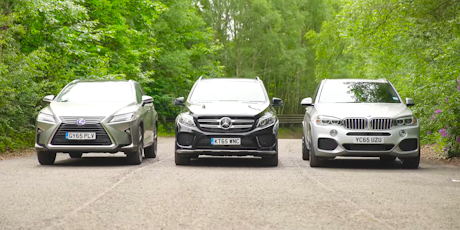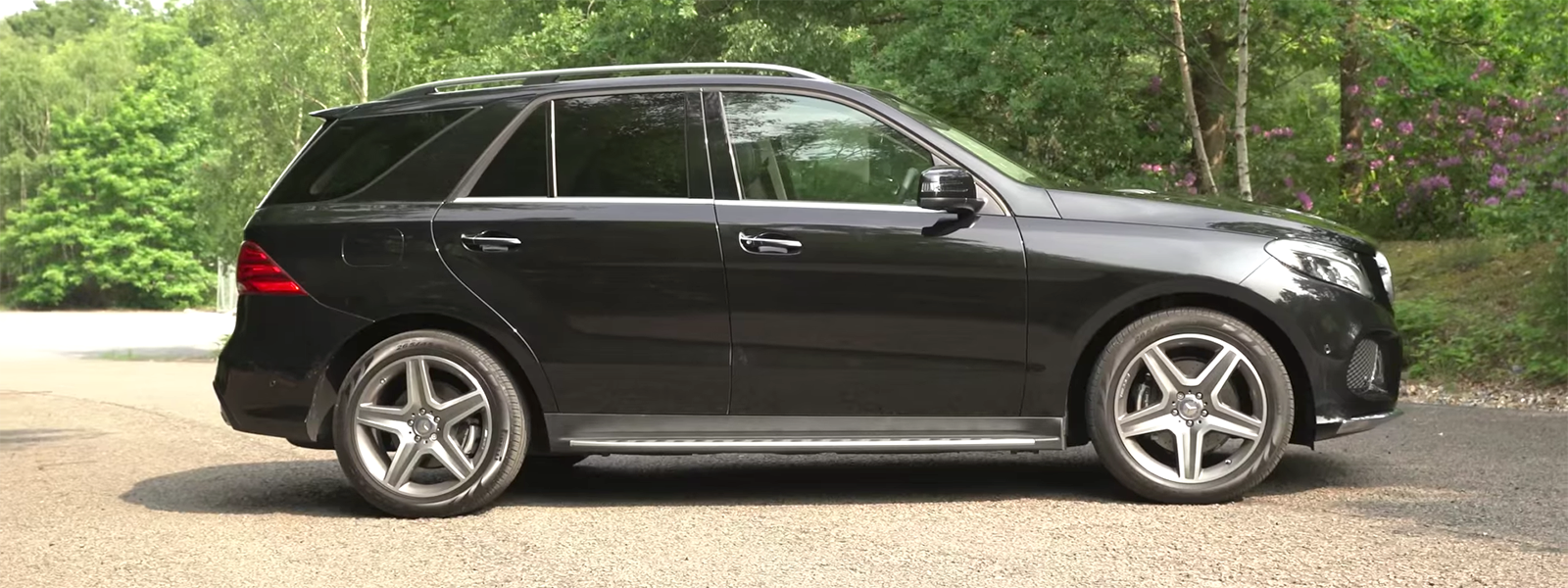Which is best: Mercedes GLE, Lexus RX, BMW X5?
December 09, 2016 by carwow staff

Few cars scream ‘status symbol’ as much as premium SUVs. These posh 4x4s blend imposing style with a fancy badge and premium features to lift their drivers above other road users.
Three contenders for top honours in the class are the Mercedes GLE, Lexus RX and BMW X5 but which is best? We compare the three to find out who’s king of the soft-road class.
To see how much carwow could help you save on your next big SUV – or any other car you might fancy – take a look at our new car deals page. Find more video reviews by Mat Watson on our YouTube channel.

Mercedes GLE vs Lexus RX vs BMW X5 prices
Prices for the GLE are the highest of the three, with the diesel-powered GLE250d costing just more than £49,000. The model you see here, the 350d, costs about £56,000 before options, while the hybrid GLE 500e costs from £65,000.
The entry-level Lexus RX200t is cheaper, costing from £40,000. The Hybrid model tested here is priced at just less than £47,000. The BMW X5’s prices fall between the two – the range kicks off with the £44,500 X5 sDrive25d, with the Hybrid model in the video costing £52,105.

Mercedes GLE vs Lexus RX vs BMW X5 styling
The GLE is big, imposing and suitably chunky enough to fit the premium SUV bill. The stepped running boards aren’t just appropriate for a big SUV but a necessity if you’re short. Its bodywork might be fairly new but it struggles to hide the fact the GLE is really a heavily facelifted old M-Class. However, the oversized Mercedes badge on the nose still commands respect.
In comparison, the Lexus looks a little bit barmy. Its futuristic design is dominated by Lexus’ huge signature ‘spindle’ front grille, while the rest of the body is a riot of sharp creases, wavy surfaces and clashing lines. Some will find it too daring in a class that’s fairly conservative, but those wanting to stand out need look no further.
The BMW is the most aggressive looking of the three. Wide trademark ‘kidney’ grilles at the front blend into a pair of frowning headlamps lending it a bullish presence. Like the GLE, however, this is another car that is beginning to show its age, especially compared to the space-age Lexus.

Mercedes GLE vs Lexus RX vs BMW X5 interior
The GLE might have joined the Mercedes range in 2015 but, as mentioned, it’s essentially a revised M-Class – a car Mercedes has sold since 2011. As a result, the GLE’s cabin isn’t the most modern inside, although build quality is great. The biggest culprit is the dashboard that’s scattered with buttons and, while the infotainment system looks pretty, its menu layout is confusing.
The infotainment system in the RX is the weakest here, however. The screen is large and clear, but the mouse-type controller is weird and irritating to use, forcing you to ‘guess’ where on-screen buttons are. That gripe aside, the RX cabin is gorgeous – the layout is clear and contemporary, the build quality and materials are the best here, and the seats are the comfiest both front and rear, too.
The X5’s interior design looks as sporty as you’d hope from a BMW. The centre console is angled slightly towards the driver and the three-spoke steering wheel looks great and feels nice to hold. The materials feel sturdy and buttons are placed where you’d expect them, but the design is a little dated. The highlight is BMW’s iDrive infotainment system with clear menus and a logical layout.

Mercedes GLE vs Lexus RX vs BMW X5 practicality
Each of these cars is big, spacious and practical, but it’s the Mercedes that’s the most practical overall. There’s plenty of head and legroom inside, and cubby spaces are more generous than the other two. Its huge 690-litre boot is also the largest of the three.
The GLE’s boot volume completely eclipses the disappointing 453 litres in the Lexus. Blame its hybrid system for the shortfall – storing the electric motor and battery means the boot floor is higher than its rivals. For four people, the RX is arguably the most comfortable here thanks to its excellent head and legroom, although middle-rear passengers might find it a squeeze.
If you’ll regularly be carrying five, the X5 is the best of the three. The wide bench makes it comfy for three adults and the centre seat is the most accommodating here. The 650-litre boot can’t quite match the GLE, but it’s still massive. The electric parts in hybrid models drops that figure to a more modest 500 litres, though.

Mercedes GLE vs Lexus RX vs BMW X5 engines
The GLE is offered with four engines – two diesels, one hybrid and the bonkers twin-turbocharged V8 petrol in the Mercedes-AMG GLE63. The 3.0-litre diesel is the one to have – the V6 is smooth and offers loads of low-down power while managing a claimed 42.8mpg. The smaller 250d is more efficient but feels underpowered in such a big car.
The Lexus is only offered with two engines – a 2.0-litre turbocharged petrol and a 3.0-litre hybrid. The fact there isn’t a diesel option will put off some buyers but, in reality, the hybrid will be a great choice for many. Two electric motors back up the V6 petrol engine, meaning the Lexus can cruise short distances in near-silent electric mode.
Not that it’s exactly noisy when the engine kicks in – at a cruise, the RX is the quietest here. Mated to a CVT automatic gearbox, the engine can drone a little under very hard acceleration, but stays mostly quiet. It claims to return 54.3mpg and, despite Mat’s leaden feet, it achieved impressively close to that on test.
The BMW’s engine lineup is the most comprehensive of the bunch, with four diesel options, two petrols and a hybrid. The hybrid might make bold claims about fuel consumption but, in reality, the 85.6mpg figure is only plausible if you cover short journeys. We’d go for one of the diesels instead – they’re a great match for a big SUV and offer better performance for the price.

Mercedes GLE vs Lexus RX vs BMW X5 driving
From behind the wheel, the Mercedes feels exactly as solid and secure as those bulky proportions suggest. A car of this size will never trouble a sports car along a twisty road, but it manages its heft well – there’s plenty of grip and body roll isn’t extreme. The ride is composed – particularly with the air suspension system – and, overall, it’s a relaxing place to while away the miles.
The Lexus offers air suspension as standard, and it’s set up for maximum comfort. The relaxing setup is a perfect match for the rest of the car’s character – floating over bumps and massaging its occupants from one location to the next. It corners tidily enough, if not with the same sharpness of the BMW or the Mercedes.
True to the rest of the brand’s offerings, the BMW X5 feels the sportiest to drive. It manages to hide its weight very well, slicing into corners with impressive agility for such a big car. The extra weight of the hybrid version makes it feel noticeably more bloated than other models, however – another reason why we’d recommend the conventional diesel versions.
The X5’s tidy handling hasn’t come at the expense of comfort though – it handles bumps very well. Unfortunately, your ears won’t be quite as content as your bum – there’s too much road noise transferred into the cabin via the cartoonishly wide tyres. Wind noise is more noticeable than in the others, too.
It’s unlikely that any of these cars will see terrain more taxing than a muddy field but, if the need takes you, the GLE will be the best of the three off-road – a low range option for the automatic gearbox and adjustable ride height sees to that.

Verdict
Each of these upmarket SUVs offers plenty to like and each will appeal to a slightly different buyer. The BMW is best choice for keen drivers, with strong performance and sharp handling. That isn’t the only deciding factor for premium SUV buyers and, in some other areas, the X5 is starting to feel a little dated.
The Mercedes GLE is also starting to show its age in one or two areas, most obviously in its cabin design. Otherwise, it looks the part though, and the relaxed, comfortable driving experience still offers plenty to like.
Look past the lack of a diesel engine and love-it-or-loathe-it looks, and the Lexus is tough to fault. It has the best interior here, the hybrid offers decent economy, it’s wonderfully relaxing to drive and, thanks to Lexus’ brilliant reliability ratings, it should have fewer ownership headaches than the other two. Overall, it wins this test.
Save money on your next new car
To find out more about each of these cars and see how much carwow could help you save, take a look at our new car deals page. For more of Mat Watson’s video reviews, head over to our YouTube channel.















